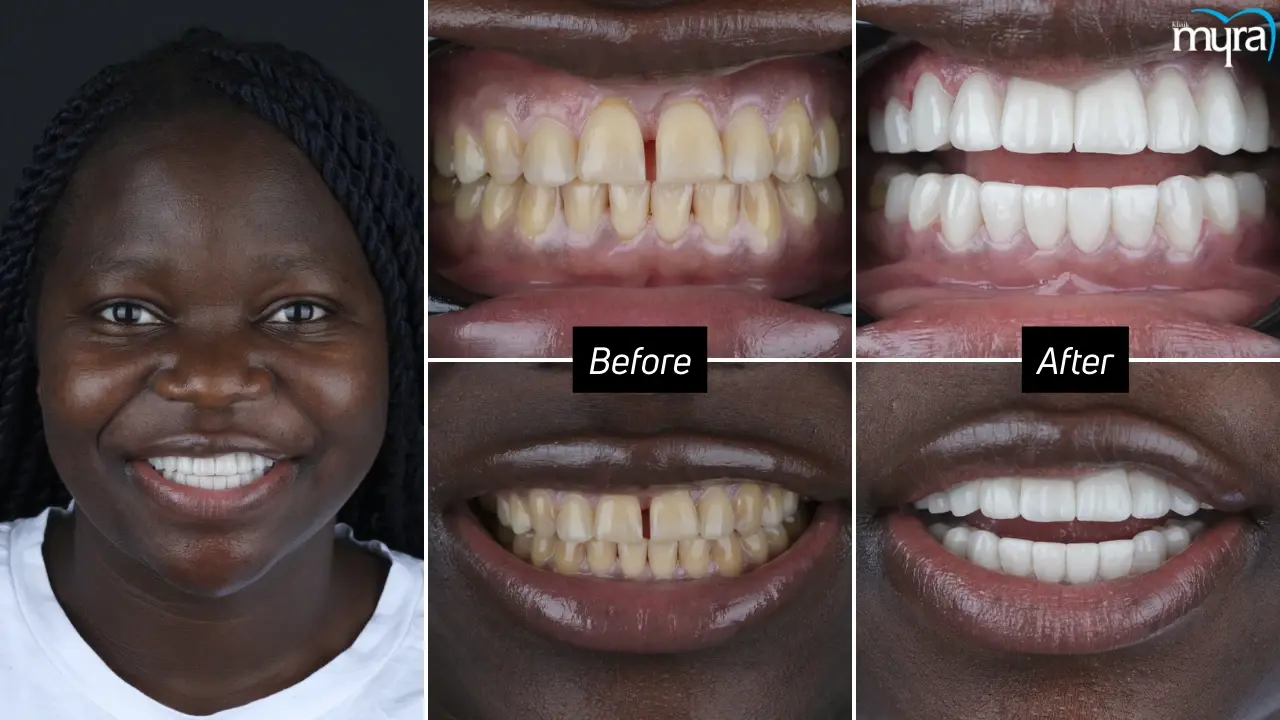A diastema is a space that exists between teeth. These gaps occur between any teeth but are most commonly seen between the upper front teeth, resulting in "separated teeth." The condition varies, with some individuals having small, barely noticeable spaces while others have a more pronounced or "huge gap in teeth." Diastema manifests as "gaps bottom teeth" in the lower dental arch. The dental problem affects children and adults and is influenced by genetics, dental development, and oral habits.
Types of diastema are categorised based on their location and underlying causes. The most common type is the midline diastema, the gap between the upper front teeth. Another type is mandibular diastema, which occurs in the bottom teeth between the lower front teeth. Diastema occurs between other teeth in the mouth, resulting in "gaps between all teeth." The causes of diastema include the disproportionate size of teeth and jawbone, missing or undersized teeth, an oversized labial frenum, periodontal disease, and certain oral habits like thumb sucking and tongue thrusting.
Treatments are available to close diastema and improve the teeth' function and aesthetics. Dental bonding is a common and cost-effective method for filling small gaps using a tooth-coloured resin. Braces or clear aligners gradually move the teeth into the correct position for larger or more complex cases, effectively closing the "huge gap in teeth." Veneers and crowns are popular options for patients seeking immediate cosmetic results. A frenectomy (surgical removal or modification of the frenum) is necessary in cases where an oversized labial frenum results in a diastema. Dental implants or bridges replace missing teeth, thus eliminating the gaps. Each treatment plan is tailored to the individual's needs to ensure optimal results and restore a confident, seamless smile.
What is Diastema?
"Diastema" is the medical term for a space between teeth. The two front teeth are the most common location for midline diastema. The gaps between the teeth vary, ranging from slight separations to larger spaces.
Diastema is "separated teeth" or a "side teeth gap." The terms highlight the condition's physical appearance, which involves a noticeable space between the teeth, particularly the front ones. Diastema does not harm dental health or affect the functionality of the teeth or gums, but it indicates underlying gum disease. The condition affects children and adults, though it is more prevalent in children. The gaps in children's teeth close naturally as their permanent teeth come in.
People with certain traits are more likely to have midline diastema, a space between the two front teeth on the upper jaw. It is observed more frequently in individuals who are Black compared to people who are white or of Asian descent. People worried about the appearance or health risks associated with diastema want to consult a dentist, although in most cases, medical intervention is unnecessary.
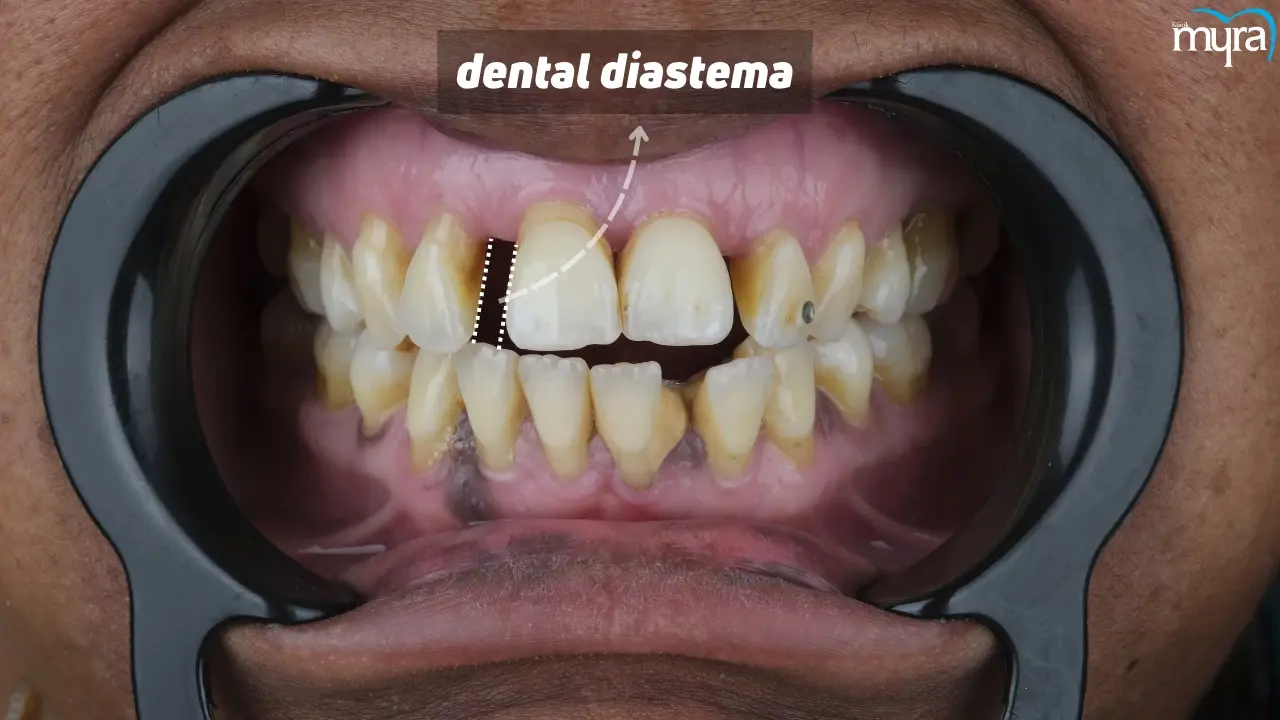
What does Diastema look like?
Diastema looks like a gap between the teeth that is more comprehensive than 0.5 millimetres (0.02 inch). The gaps appear at any location in the mouth but are commonly found between the upper front teeth. Mandibular diastema describes how these spaces exist in the lower teeth. A gap between the upper or lower central incisors (the two front teeth) is called a midline diastema. The presence of a gap between the two maxillary (upper) central incisors is called maxillary midline diastema (MMD).
A maxillary midline diastema is a type of dental problem considered normal in children and does not require treatment, as it closes naturally as permanent teeth come in. Diastema is noticeable as "separated teeth" with a distinct "side teeth gap," creating visible gaps that are aesthetically concerning for some individuals.
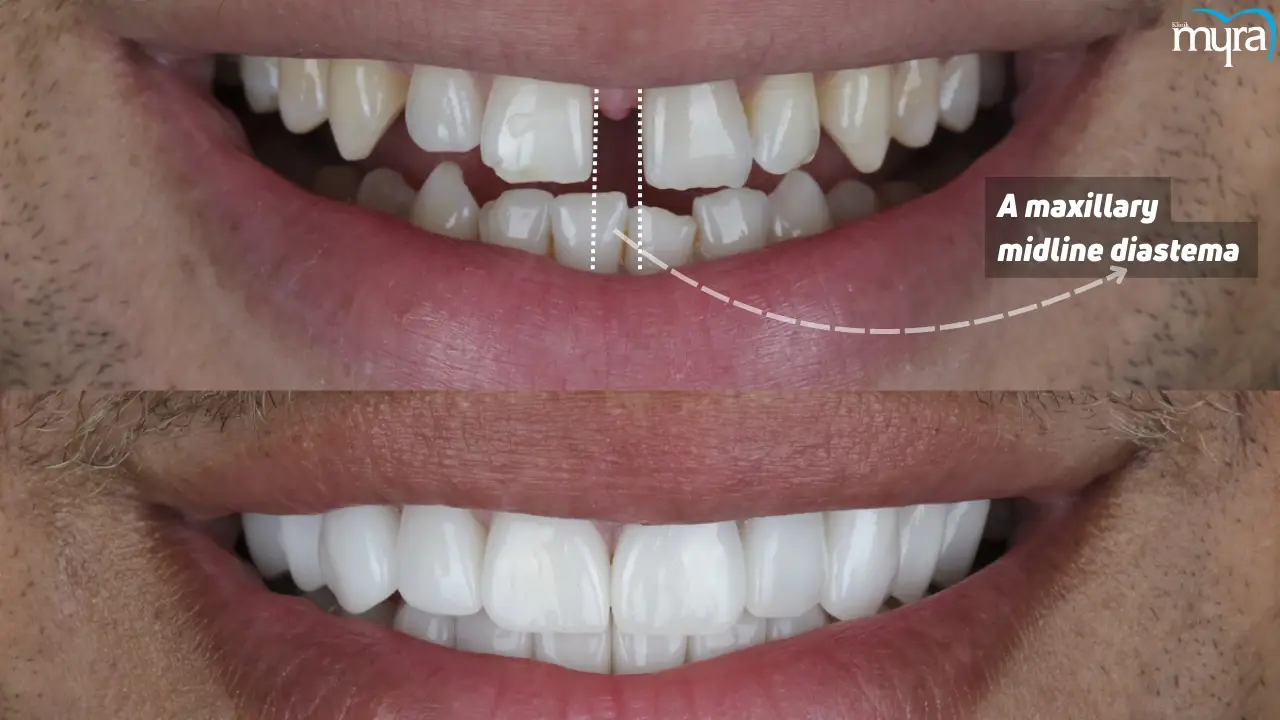
Who is affected by a diastema?
Diastema affects children and adults. Diastema is more common in children, and gaps between their teeth close once permanent (adult) teeth come in. Midline diastema, with a gap between the two upper front teeth, is more prevalent among specific populations.
Diastemas are not harmful and do not require treatment unless pursued for cosmetic reasons. Children's gaps close as their permanent teeth come in, but sometimes, diastemas last into adulthood. The persistence is due to various factors, including genetic predisposition, tooth size, and dental habits. Adults sometimes get treatment to close these gaps to make them look better or bite better.
How does Diastema affect Oral Health?
A diastema does not affect oral health, but it does if periodontitis is the cause. Diastema affects oral health when associated with underlying conditions, such as gum disease. Individuals experience bright red and swollen gums that bleed easily, receding gums, bad breath, and loose teeth. The symptoms indicate that the gap is not merely a cosmetic issue but a sign of more severe gum disease.
Gum disease damages the supporting bone and gum tissue, causing teeth to become loose. Increased tooth mobility results in discomfort or pain, especially when biting or chewing. The instability of the teeth due to the compromised support exacerbates oral health problems and leads to further dental complications if not treated promptly. A diastema does not directly affect oral health, but the fact that it is linked to gum disease has profound effects. Take care of diastema's cosmetic appearance and health aspects to maintain dental health.
What are the types of Diastema?
The types of Diastema are listed below.
Mandibular Diastema: A mandibular diastema is a gap that exists between teeth in the lower jaw or mandible. Mandibular diastema occurs anywhere along the lower teeth but is found between the lower central incisors. Midline diastemas result from various factors, including tooth size discrepancies, dental habits, or underlying gum disease.
Midline Diastema: A midline diastema is a gap between the two upper front teeth, the central incisors. It is most common in children and closes naturally as permanent teeth come in.
1. Midline Diastema
Midline diastemas exist between the upper front teeth. The condition is called "diastema" in dental literature. Regular development and growth, habits in the mouth, jaw or soft tissue abnormalities, physical constraints, teeth or jawbone abnormalities, and skeletal disharmonies cause midline diastema.
The main difference between midline diastema and mandibular diastema lies in their location and frequency of occurrence. Midline diastema occurs in the centre of the upper front teeth (central incisors) and in the maxillary arch (upper jaw). A mandibular diastema is found at the centre of the lower front teeth, located in the mandibular arch (lower jaw). Midline diastema is more common than mandibular diastema, which occurs less frequently. The causes vary.
Midline diastema results from a mismatch between the size of the upper jaw and teeth, hereditary factors, prolonged thumb sucking, pacifier use, or the presence of a supernumerary tooth. Mandibular diastema results from genetics, trauma, extra teeth in the lower jaw, a size difference between the lower jaw and teeth, or habits like tongue thrusting. Midline and mandibular are similar in occurrence, as they are considered normal and do not need medical attention. Orthodontic treatment, dental bonding, and veneers are viable alternatives to either type of treatment, mainly when the separation is substantial, results in functional complications, or influences self-esteem in terms of appearance.
2. Mandibular Diastema
A mandibular diastema is a gap in the centre area of the lower front teeth. Mandibular diastema is less common than midline diastema and is caused by various factors, including genetics, trauma, or additional teeth (supernumerary teeth) in the lower jaw. The condition results from a disparity between the size of the lower jaw and the teeth and habits like tongue pushing.
The space's location is the primary characteristic distinguishing mandibular diastemas from other diastemas. Mandibular diastemas are located within the bottom front teeth, while midline diastemas are found between the upper front teeth. Both types of diastemas share similar root causes and treatment options. Midline diastema gets more attention because it happens more often, but mandibular diastema is a challenge for function and appearance, even though it happens less often. Treatment for a mandibular diastema is not necessary if the condition is considered normal. Orthodontic treatment, dental bonding, or veneers are suggested if the space is large, makes eating or speaking difficult, or if the patient experiences self-consciousness due to their appearance.
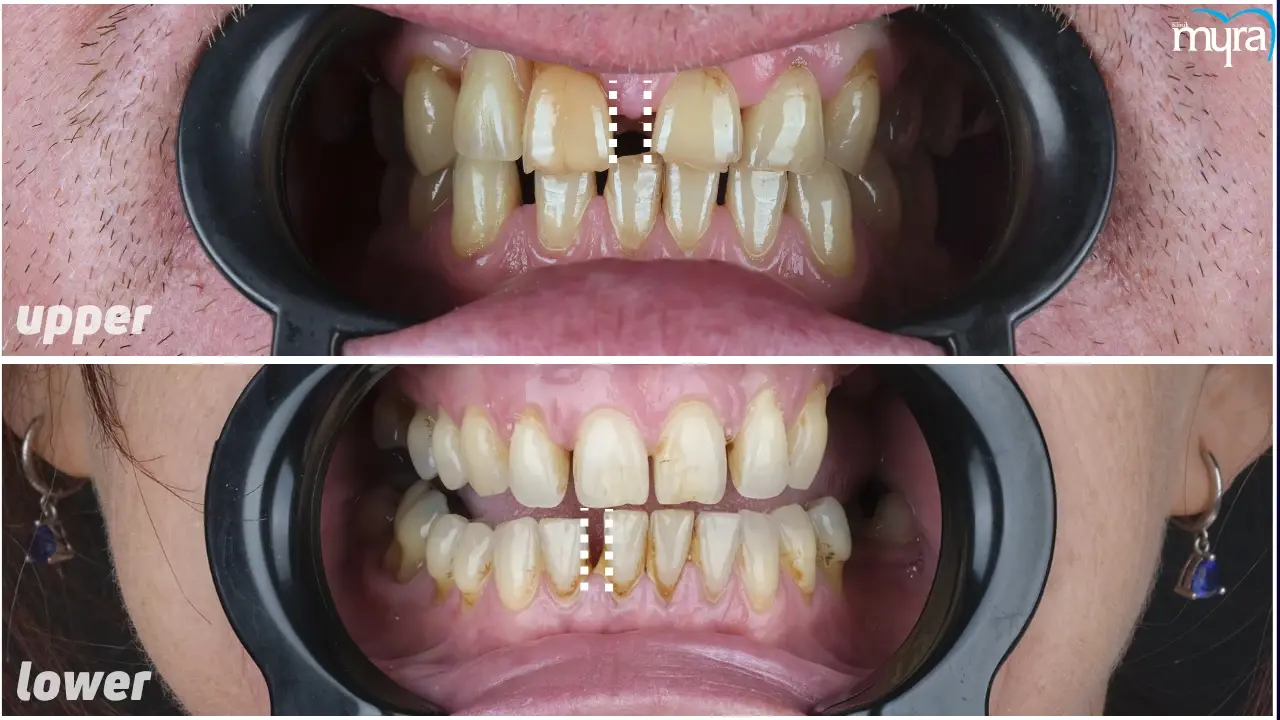
What are the causes of Diastema?
The causes of Diastema are listed below.
- Gum Disease: Periodontal disease causes severe gum disease and results in tooth migration. Inflammation damages the bone that supports the teeth, causing them to become loose and create gaps.
- Incorrect Swallow Reflex: The tongue must press against the roof of the mouth when swallowing. The front of the tongue presses against the front teeth. The repeated pressure pushes the teeth forward, creating a space.
- Habits: Behaviours such as thumb sucking, lip sucking, and tongue thrusting increase pressure on the front teeth, moving them forward and resulting in gaps or diastemas.
- Loss of Primary Teeth: Temporary gaps called diastemas appear when kids lose their primary (baby) teeth. These gaps close as the permanent (adult) teeth come in. The type of space is considered a natural and healthy part of dental development, requiring no medical intervention.
- The Size of the Teeth Concerning the Jawbone: Spaces form between the teeth if they are too small in proportion to the jawbone's size. Genetics determines the size discrepancy, making diastemas more common in families.
- Missing or Undersized Teeth: Diastema occurs when some teeth are absent or significantly more minor than others. It is noticeable with the upper lateral incisors, where a space forms between the two front teeth if these incisors are missing or very small.
- Oversized Labial Frenum: The labial frenum is the tissue that runs from the inside of the top lip to the gum above the upper front teeth. An enlarged labial frenum creates a gap between these teeth if the tissue is extensive.
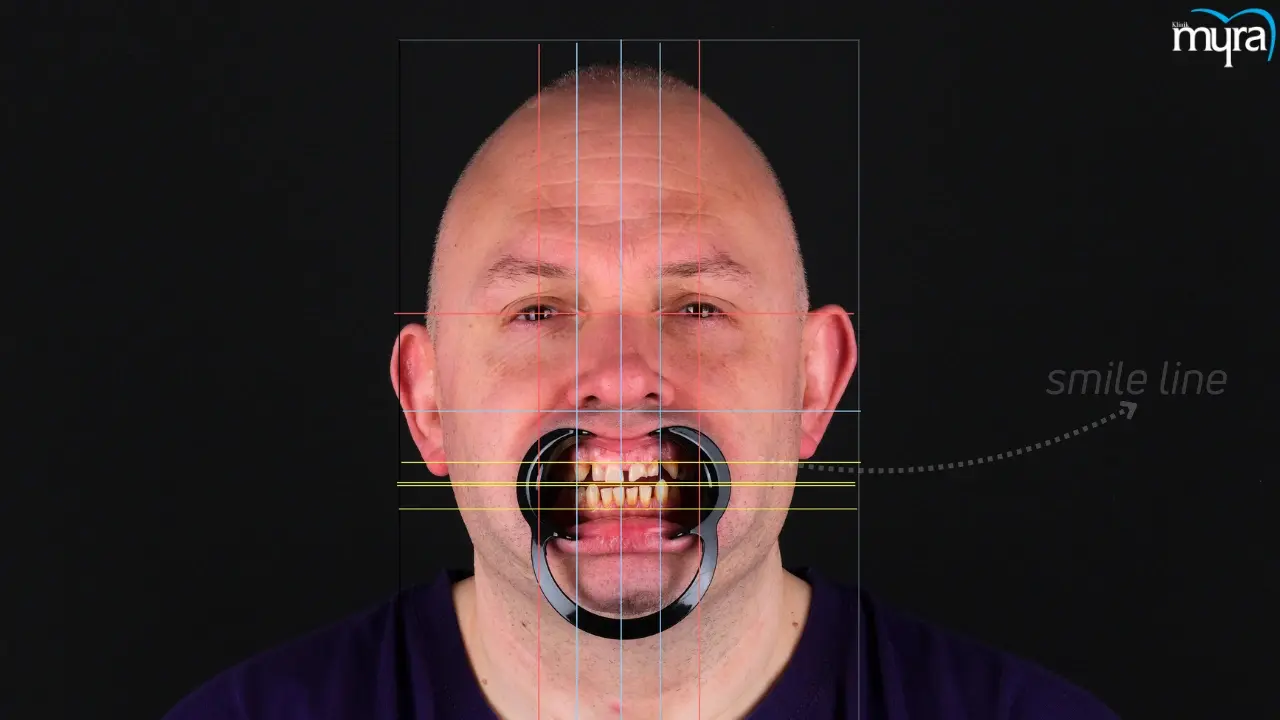
How is Diastema diagnosed?
Diastema is diagnosed by trained dental experts during a routine dental checkup. The dentist or orthodontist visually examines the patient's teeth and uses X-rays or other diagnostic techniques to understand better the size and position of the gap in the patient's teeth. The visual examination helps the dental professional assess the alignment of the teeth and identify any discrepancies contributing to the diastema.
The dentist or orthodontist questions the patient about their medical and dental history and any behaviours or environmental circumstances contributing to the diastema formation. Understanding the patient’s history provides valuable insights into potential causes, such as genetic factors, oral habits like thumb sucking, or any trauma that has affected the teeth and jaw alignment. The qualified expert searches for any indicators of tooth decay, gum disease, or other oral health disorders connected to the diastema during the examination. These underlying issues are crucial, as they influence the treatment approach and dental health.
Dentists and orthodontists discuss treatment options with patients once a diagnosis has been made. They consider the patient’s unique requirements and desires before making a recommendation. Treatment options include orthodontic solutions like braces, dental bonding, veneers, or surgical intervention in more severe cases. The goal is to provide a tailored treatment plan that addresses the diastema's aesthetic and functional aspects.
What are the options for treating Diastema?
The options for treating Diastema are listed below.
- Dental Bonding: Dental bonding involves applying tooth-coloured resin material to the teeth to fill the gaps. A minimally invasive procedure is completed in one visit. It is ideal for small gaps and provides immediate results.
- Braces: Braces are a standard orthodontic treatment for correcting gaps between teeth. Traditional metal braces or clear aligners, such as Invisalign, gradually move the teeth into the desired position. The treatment is suitable for more significant gaps and tooth alignment issues.
- Frenectomy: A frenectomy is a surgical procedure that involves removing or altering the labial frenum, the tissue that causes a gap between the front teeth if it is oversized. The method is combined with orthodontic treatment to achieve the best results.
- Dental Bridge: Dental bridges fill in gaps left by one or more missing teeth. They consist of artificial teeth anchored to the adjacent natural teeth or dental implants. The option is suitable for cases where gaps are due to missing teeth.
- Dental Implant: A dental implant is a surgical procedure in which a titanium post is inserted into the jawbone as a substitute root for a missing tooth. An artificial tooth is attached to the post. It is a long-term solution for gaps caused by missing teeth and gives a natural look and feel.
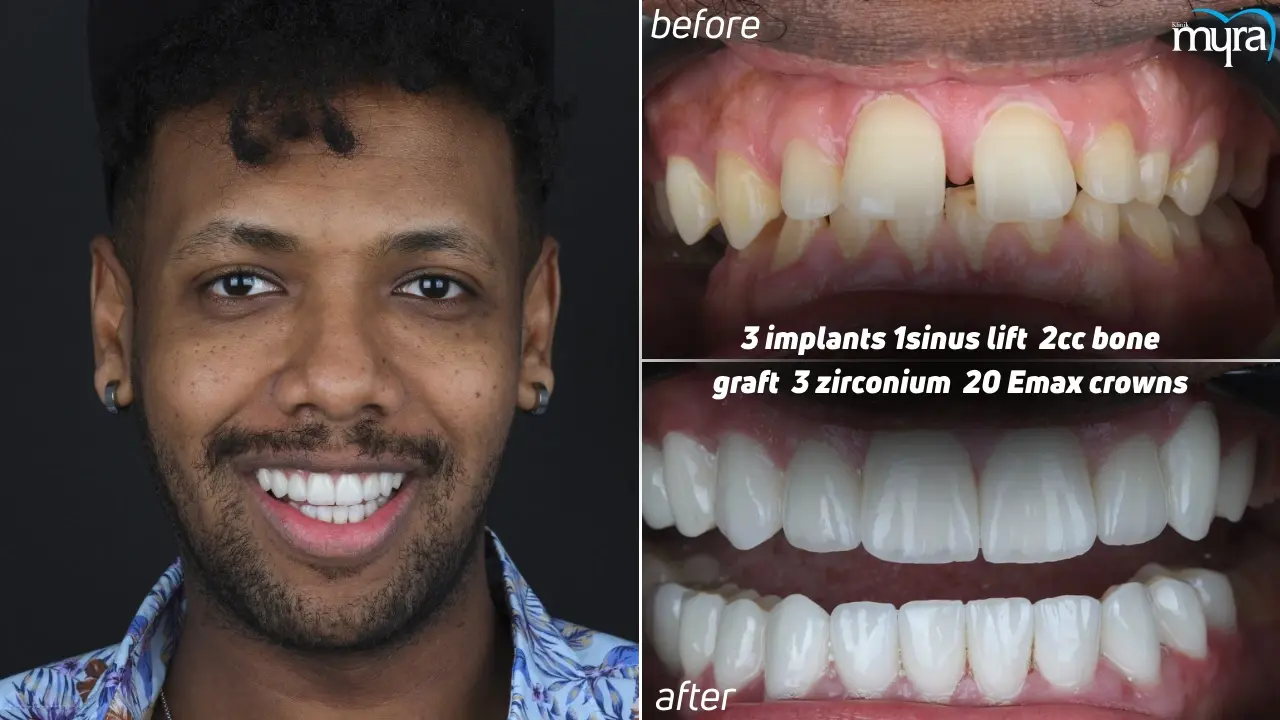
1. Dental Bonding
Dental bonding is a procedure for restoring teeth that are separated between the upper front teeth. Diastema bonding involves applying a tooth-coloured composite resin to fill the space between teeth. The method is recommended for gaps less than 2 mm wide.
The longevity of dental bonding ranges from 3 to 10 years, depending on factors such as oral hygiene, eating habits, and the quality of the composite resin used. Staining or colour changes occur with composite materials over time, impacting their durability and aesthetics.
Dental bonding is less expensive than porcelain veneers. The dental bonding cost in Turkey starts from £109 to £385 but varies widely depending on the procedure's complexity and the dental practice's location. It is more affordable for patients with a smaller budget.
Dental bonding is adequate for addressing minor cosmetic dental issues, including gaps between teeth. Most patients experience positive results with dental bonding. The procedure offers a quick and affordable cosmetic solution in one visit, taking one hour. It is much simpler than applying porcelain veneers and doesn't require reducing the existing tooth. No anaesthesia is needed for the bonding treatment, and the composite material is adjusted to meet the patient's aesthetic goals. Porcelain veneers outperform dental bonding in terms of durability and stain resistance.
2. Braces
Braces are an orthodontic treatment that straightens teeth, closes spaces between teeth (diastema), and fixes other misalignment issues. Braces are metal or ceramic brackets attached to the teeth and connected by wires and elastic bands. Braces apply continuous pressure over time to move teeth into the desired position. A full set of braces is needed on the upper and lower teeth because moving any teeth affects the entire mouth.
The duration of orthodontic treatment with braces ranges from 18 months to 3 years, depending on the severity of the corrected dental issues and the patient's adherence to treatment protocols. Patients get retainers to keep their teeth in the new position after removing braces.
The cost of braces varies widely based on the complexity of the treatment, the type of braces used (metal, ceramic, or lingual), and the location of the orthodontic practice. The cost of braces in Turkey is roughly £1,256. Insurance covers part of the cost if the braces are medically necessary.
Braces are highly effective for treating diastemas and other orthodontic issues. They provide a comprehensive solution that closes gaps, aligns the teeth, and improves the bite. Braces offer long-term results when followed by the proper use of retainers. The results are permanent and tackle several oral health issues simultaneously.
3. Frenectomy
A frenectomy is a surgical procedure that involves reshaping, shortening, or removing a band of tissue called the frenum. The frenum is the part of the upper lip that connects the inside to the gum tissue between the upper front teeth roots. It is used in orthodontic treatment.
The effects of a frenectomy are permanent. Once the excess tissue is removed or reshaped, it doesn't grow back. The long-term success of the procedure depends on proper timing and follow-up care. Spacing problems are avoided if the procedure is done before the permanent teeth come in. The tooth's new position is better preserved with the procedure performed after orthodontic treatment. A fixed retainer is recommended for at least a year after the procedure to ensure stability.
The price of a frenectomy in Turkey is approximately £220. The cost varies depending on several factors, including geographic location, the complexity of the procedure, the dentist or oral surgeon's experience, and whether it's performed alone or as part of a broader orthodontic treatment plan. Consult an orthodontist or dental insurance provider for accurate cost information.
Frenectomies are highly effective when performed at the right time and for the right reasons. Preventing spacing issues is achieved by doing it before permanent teeth erupt. Space closure is most effective after orthodontic treatment has closed existing spaces. Maintaining the teeth' new position is easier with orthodontic treatment and proper retention. The long-term benefit is that it keeps the gaps between teeth from getting wider after orthodontic treatment is completed. The effectiveness depends on proper timing and technique. For example, a standalone frenectomy after permanent teeth have erupted makes it hard to close existing spaces on their own. The best results are achieved when the procedure is part of a comprehensive orthodontic treatment plan.
4. Dental Bridge
Dental bridges permanently attach an artificial tooth to two or more neighbouring teeth or dental implants to create an entire arch of restored teeth. Dental bridges replace one or more missing teeth. They bridge the gap created by one or more missing teeth, restoring function and appearance.
The lifespan of a dental bridge ranges from 5 to 15 years, depending on the material used, the patient's oral hygiene practices, and regular dental check-ups. Bridges last even longer if the patient takes good care of them.
The cost of dental bridges in Turkey varies depending on several factors, but they are more affordable than in many Western countries. The approximate cost of a dental bridge in Turkey is around £157. For example, a three-unit Zirconia dental bridge in Antalya, Turkey, costs approximately £627. Factors affecting the cost include the material used (e.g., zirconia, metal, all-ceramic, or porcelain-fused-to-metal), the number of missing teeth to be replaced, the position of the missing teeth in the mouth, the complexity of the bridge design, and any additional procedures required (e.g., implants or extractions).
Replacing missing teeth, restoring functionality, and improving aesthetics are highly effective with dental bridges. They help maintain the structure of the face, prevent remaining teeth from shifting out of position, and improve speech and chewing ability. Their effectiveness depends on the health of the surrounding teeth and gums and the patient’s commitment to maintaining good oral hygiene. Regular dental visits are essential to monitor the bridge's condition and ensure it remains in good working order.
5. Dental Implant
Dental implants are a permanent solution for treating midline diastema (a gap between teeth, the front teeth). A dental implant involves surgically inserting metal screws into the patient's jawbone and attaching replacement teeth to close the gap. Dental implants improve aesthetics and restore full functionality to the mouth.
Dental implants are designed to be a long-lasting, permanent solution for tooth replacement. Implants for teeth last a lifetime if they are taken care of properly. They are considered one of the most durable and long-term solutions for treating midline diastema and replacing missing teeth.
The average cost of dental implants in Turkey is approximately £507. The best implant brand, Straumann Roxolid SLA Active, costs around £1,054. The cost of dental implants varies depending on several factors, including the number of implants needed, the case's complexity, the dentist's expertise and location, and any additional procedures required (such as bone grafting). Dental implants are more expensive than other ways to treat midline diastema, but they last longer and work better, making them the best investment in the long run.
Dental implants are highly effective for treating midline diastema in cases where missing teeth cause a gap. They provide a permanent solution, unlike temporary fixes, and offer a natural appearance, functioning like real teeth. Tooth Implants restore complete chewing and speaking abilities and help maintain jawbone density, preventing further dental issues. Dental implant procedures are highly successful when carried out by trained professionals.
How much does the Diastema treatment cost?
The diastema treatment cost ranges from £157 to £1,256 and varies widely depending on the type of treatment selected, the materials used, the specific body parts involved, and the complexity of the procedures. For example, dental bonding costs less than other treatments and is around £157. Braces cost around £1,256, making them a relatively affordable option for extensive orthodontic work. A frenectomy, which involves the surgical removal or reshaping of the frenum, averages around £220 in Turkey. Dental bridges are priced at about £627, depending on the materials and the complexity of the bridge design. Dental implants are among the more expensive options, ranging from £400 to £850 depending on the brand and additional procedures like bone grafting.
Several factors impact the cost of diastema treatment. The materials used in the procedures vary, such as the choice between composite resin for bonding, metal brackets for braces, zirconia for dental bridges, and titanium for implants. The body parts involved, such as the upper vs. lower jaws, influence the cost, mainly if the treatment complexity differs between these areas. The specific procedures required, like bone grafting in implants or the extent of orthodontic adjustments needed for braces, add to the expense. Geographic location and the experience of the dental professional performing the procedure are other critical factors affecting the cost. Their long-term benefits and effectiveness justify the investment, even if the upfront costs seem high for specific treatments.

How long does it take to Recover from Diastema Treatment?
It takes several weeks to 6 months to recover from Diastema treatment, but it varies depending on the type of procedure performed. The time it takes for the space to completely close and for patients to notice the final results of orthodontic treatments, such as braces, ranges from six months to a few years. Regular adjustments and follow-ups are necessary to ensure the teeth reach the correct position and achieve the desired outcome.
Recovery from surgical procedures, such as a frenectomy or surgery to address an underlying gum condition, is much shorter. These procedures require a recovery period of about 2 to 4 weeks. Patients expect initial healing, although complete stabilisation of the treated area takes longer depending on individual healing responses and the specific surgical intervention.
Surgical treatments provide a faster resolution, with noticeable improvements seen within a month, compared to braces, which take several months to years to heal. The specific duration depends on the chosen treatment method and the individual's unique healing process.
Does Diastema have long term side effects?
No, diastema does not have long-term side effects in most cases. Diastema does not negatively impact oral health in healthy individuals and is considered a normal variation in dental development. Age-related changes do not affect diastema. The gap must not increase over time in a healthy mouth. A dentist must be consulted if the space between teeth becomes wider with time, as it indicates the presence of gum disease.
Diastasis is not a health issue in and of itself, but it is related to or a result of other problems like gum disease or how the patient swallows. Repetitive tongue pressure against the front teeth causes gaps to form over time. Diastema is a sign of attractiveness in many cultures, and despite these concerns, many people embrace it as a unique characteristic of beauty.
Cosmetic treatments, such as dental bonding, porcelain veneers, and orthodontic treatments like braces, are available for patients concerned about the appearance of diastema. Maintaining good oral hygiene reduces the risk of infection-related diastema, and regular dental check-ups are recommended for early detection of any potential issues.
Keep an eye on oral health and see a dentist for any changes, such as wider gaps, even though diastema usually does not cause long-term side effects. Regular dental check-ups and good oral hygiene practices help ensure oral health and address potential issues early on.
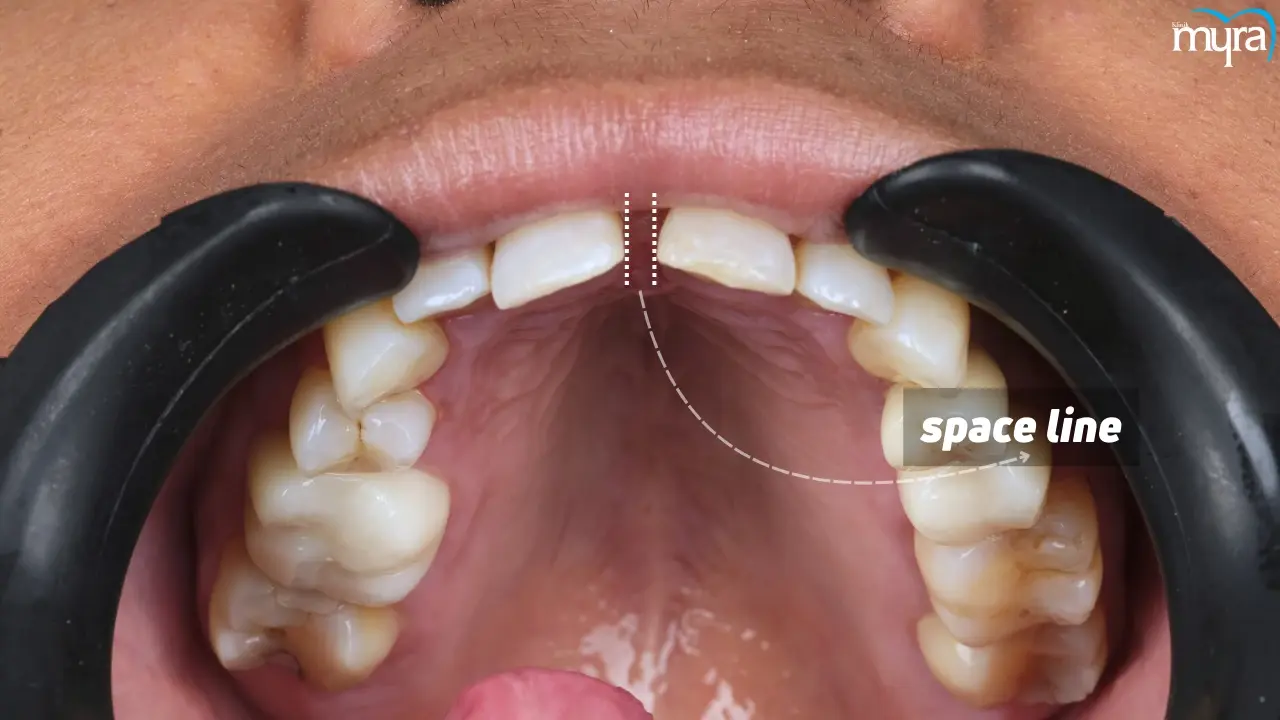
Does the size of tooth gaps increase with ageing?
Yes, the size of tooth gaps increases with ageing. The phenomenon is expected due to various factors associated with the ageing process. The muscles that support the front of the mouth loosen with age. The relaxation leads to the teeth spreading apart, creating or widening existing gaps between teeth. Ageing comes with an increased risk of periodontal disease. The bacteria below the gum tissue cause inflammation and, if left untreated, destroy the bone that holds the teeth in place. Bone loss results in the front teeth flaring out and increased spacing between teeth.
Certain oral habits that develop or persist with age contribute to widening tooth gaps. Habits such as tongue thrusting and nail-biting exert pressure on the teeth, expanding gaps. Losing back teeth, which is more common in older individuals, leads to a bite collapse. The condition causes changes in tooth positioning and increases spacing between teeth.
Changes in the jawbone as people age contribute to widening gaps. Tooth crowding towards the middle is a common consequence of shifting the jawbone midline and causes teeth to move apart in rare instances. Individuals who received orthodontic treatment in their younger years are likelier to experience slight shifts in their teeth if they neglect to wear their retainers as prescribed.
The widening of gaps between teeth is a common symptom of ageing, but it is by no means inevitable. Proper dental care and early intervention help prevent or minimise these changes. Maintaining good oral hygiene, attending regular dental check-ups, using a night guard if teeth grinding are present, and wearing retainers after orthodontic treatment are effective preventive measures. Cosmetic procedures, such as veneers, are considered for quite large gaps.
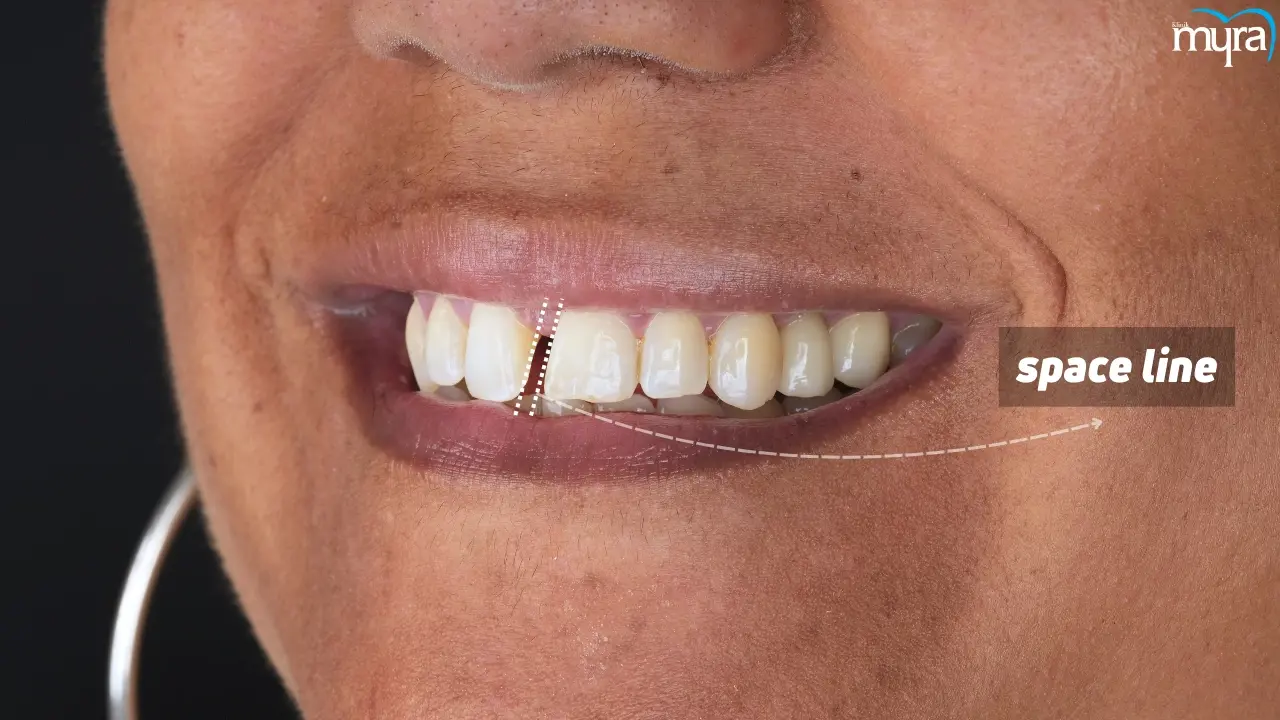
Is Diastema related to Gum Disease?
Yes, diastema is related to gum disease. Gum disease widens teeth gaps and worsens with time. Infections and inflammation damage the tooth structures that support the teeth, causing the relationship.
Gum or periodontal disease causes inflammation, damaging the bone and tissues supporting the teeth. Tooth migration, in which the teeth move out of their regular positions and form spaces called diastemas, results from the loss of the bone. A diastema that the condition causes is present along with gum disease symptoms like bright red, swollen, tender gums, bleeding gums, receding gums, and loose teeth.
People with gum disease and diastema must treat the infection before fixing the gap. Dentists focus on controlling gum disease through deep cleaning procedures, antibiotics, or other periodontal treatments to halt the progression of the disease and stabilise the oral environment. Diastema is corrected with oral health treatments such as bonding, veneers, or braces once the gum disease is under control.
Can the Turkey Teeth Procedure Close the Gap Between Teeth Problem?
Yes, the Turkey Teeth procedure can close the gap between teeth problems. The "Turkey Teeth" process is a dental treatment carried out in Turkey, a country renowned for providing cost-effective and excellent cosmetic dentistry services. Dental bonding is a frequently used therapy in the Turkey Teeth procedure to address gaps between teeth.
Dental bonding involves applying a tooth-coloured resin material to the teeth to fill gaps and reshape the teeth. The procedure is minimally invasive and is completed in a single visit. Bonding is an efficient method for filling small to moderate gaps between teeth, providing immediate results. Veneers are thin, custom-made shells of tooth-coloured materials designed to cover the front surface of teeth. They close gaps between teeth by creating a uniform appearance. Veneers are bonded to the front of the teeth and effectively mask spaces, making them a popular choice for cosmetic enhancement in the Turkey Teeth procedure.
Dental crowns are caps placed over damaged or decayed teeth to restore their shape, size, strength, and appearance. Crowns close gaps by covering the entire tooth and creating a seamless alignment with adjacent teeth. The method benefits more significant gaps or when the teeth are damaged or worn. The Turkey Teeth Procedure uses these techniques to address gaps and improve the smile's aesthetics. Dentists maximise the closure of the gap between teeth, resulting in a more uniform and appealing smile, by tailoring treatment plans to each patient's requirements.
